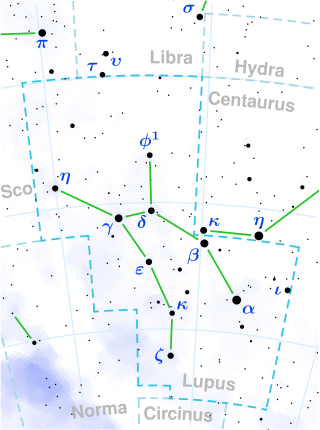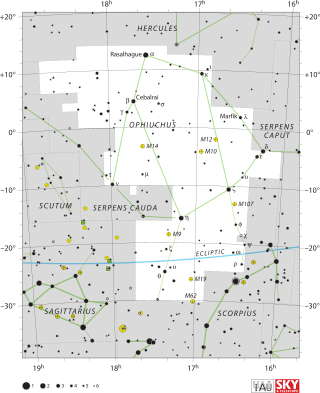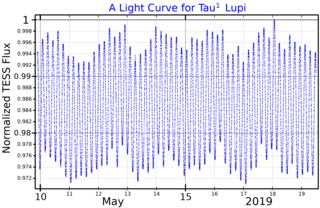
Mimosa is the second-brightest object in the southern constellation of Crux, and the 20th-brightest star in the night sky. It has the Bayer designation β Crucis, which is Latinised to Beta Crucis and abbreviated Beta Cru or β Cru. Mimosa forms part of the prominent asterism called the Southern Cross. It is a binary star or a possible triple star system.

Beta Centauri is a triple star system in the southern constellation of Centaurus. It is officially called Hadar. The Bayer designation of Beta Centauri is Latinised from β Centauri, and abbreviated Beta Cen or β Cen. The system's combined apparent visual magnitude of 0.61 makes it the second-brightest object in Centaurus and the eleventh brightest star in the night sky. According to dynamical parallax measurements, the distance to this system is about 361 light-years.

Musca is a small constellation in the deep southern sky. It was one of 12 constellations created by Petrus Plancius from the observations of Pieter Dirkszoon Keyser and Frederick de Houtman, and it first appeared on a celestial globe 35 cm (14 in) in diameter published in 1597 in Amsterdam by Plancius and Jodocus Hondius. The first depiction of this constellation in a celestial atlas was in Johann Bayer's Uranometria of 1603. It was also known as Apis for 200 years. Musca remains below the horizon for most Northern Hemisphere observers.

Sigma Scorpii, is a multiple star system in the constellation of Scorpius, located near the red supergiant Antares, which outshines it. This system has a combined apparent visual magnitude of +2.88, making it one of the brighter members of the constellation. Based upon parallax measurements made during the Hipparcos mission, the distance to Sigma Scorpii is roughly 696 light-years (214 parsecs). North et al. (2007) computed a more accurate estimate of 568+75
−59 light years.

Delta Crucis or δ Crucis, also identified as Imai, is a star in the southern constellation of Crux, and is the faintest of the four bright stars that form the prominent asterism known as the Southern Cross. This star has an apparent magnitude of 2.8, and its proper name was adopted by the International Astronomical Union on 10 August 2018. Imai is a massive, hot and rapidly rotating star that is in the process of evolving into a giant, and is located at a distance of about 345 light-years from the Sun.
ω1 Scorpii, Latinised as Omega1 Scorpii, is a star in the zodiac constellation of Scorpius. With an apparent visual magnitude of 3.95 it can be seen with the naked eye, 0.22 degree north of the ecliptic. Parallax measurements of this star give an estimated distance of around 470 light years from the Sun. It is a member of the Scorpius–Centaurus association.
Beta Cephei variables, also known as Beta Canis Majoris stars, are variable stars that exhibit small rapid variations in their brightness due to pulsations of the stars' surfaces, thought due to the unusual properties of iron at temperatures of 200,000 K in their interiors. These stars are usually hot blue-white stars of spectral class B and should not be confused with Cepheid variables, which are named after Delta Cephei and are luminous supergiant stars.

Alpha Lupi is a blue giant star, and the brightest star in the southern constellation of Lupus. According to the Bortle Dark-Sky Scale, its apparent visual magnitude of 2.3 makes it readily visible to the naked eye even from highly light-polluted locales. Based upon parallax measurements made during the Hipparcos mission, the star is around 460 light-years from the solar system. It is one of the nearest supernova candidates.

Epsilon Centauri is a star in the southern constellation of Centaurus. It is one of the brightest stars in the constellation with a slightly variable apparent visual magnitude of +2.30. Parallax measurements put it at a distance of around 430 light-years from Earth.

Kappa Centauri is a binary star in the southern constellation of Centaurus. With an apparent visual magnitude of +3.14, it can be viewed with the naked eye on a dark night. Parallax measurements place it at an estimated distance of 380 light-years from Earth.

Nu Centauri, Latinized from ν Centauri, is a binary star system in the southern constellation of Centaurus. The combined apparent visual magnitude of the pair is +3.41, making this one of the brightest members of the constellation. Based upon parallax measurements made during the Hipparcos mission, this star system is located at a distance of roughly 437 light-years from Earth. The margin of error for this distance is about 2%, which is enough to give an error in distance of ±10 light years.

λ Crucis, Latinized as Lambda Crucis, is a single, variable star in the southern constellation Crux, near the constellation border with Centaurus. It is visible to the naked eye as a faint, blue-white hued point of light with an apparent visual magnitude that fluctuates around 4.62. The star is located approximately 384 light-years distant from the Sun based on parallax, and is drifting further away with a radial velocity of +12 km/s. It is a proper motion member of the Lower Centaurus–Crux sub-group in the Scorpius–Centaurus OB association, the nearest such association of co-moving massive stars to the Sun.

Beta Lupi or Kekouan, is a star in the southern constellation of Lupus. It has an apparent visual magnitude of 2.7, making it readily visible to the naked eye. Based upon parallax measurements, this star is located at a distance of about 383 light-years from Earth.

Delta Lupi is a star in the southern circumpolar constellation of Lupus. In traditional Chinese astronomy, it is "the 2nd (star) of the Cavalry Officer" (騎官二). With an apparent visual magnitude of 3.2, it is the fourth-brightest star in the constellation. The distance to this star has been measured using the parallax technique, yielding an estimate of roughly 900 light-years with a 15% margin of error.

Theta Ophiuchi, Latinized from θ Ophiuchi, is a multiple star system in the equatorial constellation of Ophiuchus. It lies on the "right foot" of the serpent-bearer, just southwest of Kepler's Star, the nova of 1604. According to Richard H. Allen's Star Names: Their Lore and Meaning (1899), θ Oph together with ξ Oph formed the Sogdian Wajrik "the Magician", the Khorasmian Markhashik "the Serpent-bitten" and with η Oph the Coptic Tshiō, "the Snake", and Aggia, "the Magician". This star has an apparent visual magnitude of +3.3, making it readily visible to the naked eye. Based upon parallax measurements from the Hipparcos mission, it is roughly 436 light-years from Earth. It is 1.8 degrees south of the ecliptic and therefore subject to lunar occultations and less frequently occulted by a planet.

Beta Muscae, Latinized from β Muscae, is a binary star in the southern circumpolar constellation of Musca. With a combined apparent visual magnitude of 3.07, it is the second brightest star in the constellation. Judging by the parallax results, it is located at a distance of roughly 340 ± 13 light-years from the Earth.

Omega1 Cygni, Latinized from ω1 Cygni, is the Bayer designation for a solitary star in the northern constellation of Cygnus. It is visible to the naked eye with an apparent visual magnitude of 4.94. Based upon an annual parallax shift of 2.59 mas, it is estimated to lie roughly 1,260 light years from the Sun. Relative to its neighbors, this star has a peculiar velocity of 25.7±2.2 km/s.

Tau1 Lupi, Latinized from τ1 Lupi, is a solitary star in the southern constellation of Lupus. It is visible to the naked eye with an apparent visual magnitude of 4.5. Based upon an annual parallax shift of only 2.99 mas as seen from Earth, it is located about 1,090 light years from the Sun. Tau1 Lupi may be a runaway star having a peculiar velocity of 32.6±3.6 km/s. It is a member of the Upper Centaurus–Lupus sub-group of the nearby Sco OB2 association.

N Scorpii, also known as HD 148703, is a solitary, bluish-white hued star located in the southern constellation Scorpius. It has an apparent magnitude of 4.23, making it readily visible to the naked eye. N Scorpii was initially given the Bayer designation Alpha Normae by Lacaille but it was later moved from Norma to Scorpius. N Scorpii is currently located 550 light years away based on parallax measurements from the Hipparcos satellite and is part of the Upper Scorpius–Centaurus region of the Scorpius–Centaurus association.

BW Vulpeculae or BW Vul, is a variable star in the northern constellation of Vulpecula. It is near the lower limit of visibility to the naked eye with a typical apparent visual magnitude of 6.54. Based on an annual parallax shift of 1.15 mas, the distance to BW Vul is about 2,800 light years. It is moving closer to the Earth with a baseline heliocentric radial velocity of around −6 km/s.














